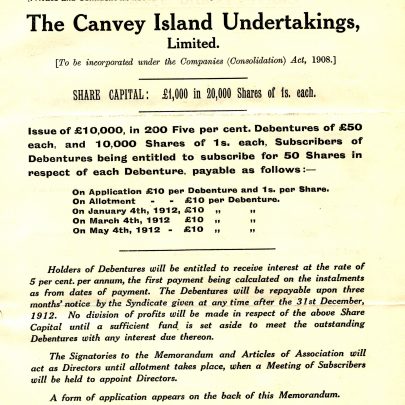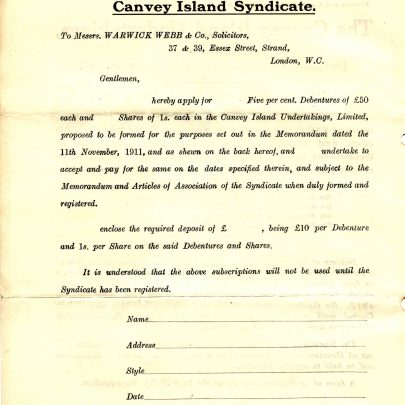Canvey Island Syndicate
110 years ago
I have recently been passed this copy of the Canvey Island Syndicate proposal. It makes very interesting reading. The subject has appeared on our website before and I will link it with this item to show the bigger picture. The item is 110 years old as shown by the date at the bottom of the 11th November 1911. How would Canvey have looked today if it had gone ahead?
Canvey Island Syndicate
 Object
Object
The Syndicate, proposed to be incorporated under the name of “The Canvey Island Undertakings, Limited,” has for its object (1) the acquisition of a large area of land in Canvey Island, on the south coast of Essex, in respect of which certain options have been obtained, or terms provisionally arranged, and (2) the promotion of a Bill in the next Session of Parliament for the incorporation of a Company with a Share Capital of £500,000 to construct a Wharf in the deep water of the River Thames, along the foreshore of part of the said land, and a railway across the said land from the Wharf to Benfleet, so as to connect with the London, Tilbury and Southend Railway, about to be acquired by the Midland Railway Company.
Upon Parliamentary Powers being granted, the Syndicate will be in a position to open out a large portion of the Island for industrial and other purposes. As the amount of land required for the purposes of the Railway and the Wharf should not exceed some 50 acres, the whole of the remaining land that may be acquired will be open for development by the Syndicate.
Advantages of situation
Canvey Island lies on the north side of the Estuary of the Thames, midway between Tilbury and Southend, being separated from the mainland by a narrow tidal channel, dry at low water. The Island has a frontage of about 4 miles to the River Thames, where, for nearly a mile, there is a natural depth of between 40 and 50 feet of water, close in shore at low tide. Nowhere else along the River Thames or its Estuary can an equal depth of water be found so close in shore and maintained naturally by the scour of the tide, thus affording exceptional berthing facilities. There is no vessel afloat, or as yet projected, that could not lie alongside a wharf at Canvey Island, and it would be accessible to the largest vessels at all states of the tide. Canvey also has the advantage of a lesser tide range than obtains higher up river, it being some 4 to 5 feet less than at London Bridge.
Accessibility
Canvey Island has the double advantage of being readily accessible both by rail and by water. By rail it is 30 miles from Fenchurch Street Station, and by water it is 35 miles, or less than a tide run for barges from London Pool.
Freehold Estate
Provisional arrangements are being made to secure for the Syndicate the right to acquire about 2,500 acres of valuable freehold lands on Canvey Island, as well as 500 or 600 acres of excellent unprotected land or saltings, easily capable of reclamation. Over the most important of these lands definite options have been obtained. Until the seventeenth century, Canvey Island consisted of some-6,000 acres of marsh grazing land, known as saltings, which were covered with water when high tides occurred. In 1623, a noted Dutch engineer, Jacob Vermuyden, afterwards knighted by King Charles the First, reclaimed about 5,000 acres by the construction of a system of sea walls, as in Holland, several hundred Dutchmen being brought over to carry out the work, many of whom settled on the Island. The effect of this reclamation was to make Canvey a rich and prosperous agricultural area, and led to the establishment of numerous farms of which about 15 old homesteads still remain, 10 of which can be secured by the Syndicate. Owing to neglect in maintaining portions of the original sea walls, the actual area of land protected by the existing embankments is 4,400 acres. During the last ten years there has been considerable residential development at the eastern end of the Island, where a large number of bungalows and small houses have been erected. The rateable value of the entire Island last year was £3,408.
River Frontage
The land controlled by the Syndicate constitutes the best portion of Canvey Island, and possesses a river frontage of about a mile in length, with all attaching water rights, along the deepest part of that river reach. The price payable for the whole of these properties (apart from the saltings) works out at less than one-third the price demanded for similar open land along the upper reaches of the river. Canvey Island is so situated at the gate of the Port of London that it only requires facilities such as the proposed Deep Water Wharf and the Railway will afford, to become an important industrial and shipping centre.* It is well-known that land possessing water facilities in convenient proximity to large docks and wharves becomes highly valuable, and it is certain that Canvey Island must appreciate in value and that large portions of the land secured by this Syndicate will command high prices.
* The average vertical range of tide off Canvey Island is about 14J feet, or practically the tame as at Antwerp where the river quays are preferred by the leading liners.
Nature of wharf
The proposed deep-water Wharf will be from 2,500 to 3,000 feet in length and about 100 feet in width, and along its entire length on the outer side there will be ample depth of water for the largest vessels at all states of the tide. On the Wharf continuous double floor flat-roofed transit sheds will be erected. Between the Wharf and the river bank will be a water space or canal, in which barges and coastwise or other small vessels may lie to load or discharge cargo along the sheltered inner side of the Wharf. Lines of rails will run along the entire length of the Wharf both inside and outside the sheds. The Wharf will be equipped with electric power cranes, winches, capstans, etc., of the most modern description. The Wharf will be capable of future extension to double or even treble the above length if required.
Capacity of wharf
The Canvey Wharf will accommodate six or seven vessels of the largest class now using the Port of London. As the back of the Wharf will also be available at all tides for barges and small craft, the working efficiency will be practically double that of an ordinary dock quay, and, on a basis of two 8-hour shifts, some 4,000,000 tons of goods could be dealt with in the course of the year. Owing to the ease and readiness with which the largest vessels will be able to berth and depart, a much larger shipping tonnage will be accommodated in a given time than is possible at any closed dock, whilst the feasibility of simultaneously loading and discharging barges at all times along the back of the Wharf will correspondingly increase the facility with which cargo can be handled, and great economy both of time and money will be effected.
Comparative cost and upkeep
The entire cost of the Canvey Wharf, with full equipment, should not exceed one-fourth the cost of a properly equipped dock of equal capacity, whilst the working expenses of an enclosed dock in the River Thames, including maintenance, mudding and interest charges, amount to not less than Is. 6d. per ton of its shipping capacity, compared with 2d. or 3d. per ton, at a Wharf such as is proposed.
Railway connection
The proposed Railway will be 2 1/2 miles in length and of full gauge and will connect at Benfleet with the London Tilbury and Southend Railway (which is about to be acquired by the Midland Railway Company) over which it will have direct through connection with the whole of England. Ample siding accommodation will be provided at the wharf end of the line.
Capital and estimated revenue
The Capital to carry out in full the proposed Wharf and Railway undertakings, including the necessary land, rolling stock and equipment together with Parliamentary and other preliminary expenses is £650,000, and the following is a conservative estimate of the Revenue that may be looked for from the combined undertakings, assuming the Wharf to be worked to but one-half its full capacity and that only one-fourth of the Cargoes are carried by rail:—
being 5 per cent, upon £150,000 Debentures and seven per cent, upon (say) £500,000 Share Capital, with £18,000 carried to reserve.
Combination of advantages
Canvey Island, with its deep water facilities, cheap barge transit, direct through railway connection, and with land acquired on terms that will- render profitable a comparatively low scale of rentals, cannot be “bettered” as an economical site for the establishment of industries and works. As a cheap and expeditious transhipment base, having regard to the serious lack of accommodation for large vessels at the Port, and to the fact that the Canvey Wharf can be opened in sections as constructed, and can be entirely completed in about eighteen months, it must command as much of the port traffic as can be accommodated.
Transhipment trade
The Transhipment trade has been largely lost by London for want of suitable and cheap facilities. This class of cargo is carried in the largest ocean vessels which necessarily feel the incidence of heavy dock charges most keenly, especially when they do not seek to discharge their entire cargo at one port. Such vessels naturally seek the cheapest ports, and are to be found in increasing numbers at Antwerp, Rotterdam and Amsterdam, where the port charges are almost nominal, being but 3d. or 4d. per ton on the vessel’s net tonnage. Such vessels will never return to London unless really cheap accommodation is provided. This is absolutely impossible by dock methods. The capital outlay on any dock capable of accommodating the enormous vessels now built, together with the fleets of barges attending them,* compels high charges, apart from the greater cost of upkeep and working which such docks involve. At a river wharf, four-fifths, or even more, of this expense may be avoided.
Cattle trade
An important feature of Canvey Island is the excellence of its pasturage, and the rich grazing it affords cattle. At the present time the ocean vessels, which annually carry the 180,000 (annual average 1905-10) odd head of live cattle and sheep brought by sea for the London Market, are unable to land them direct at the Deptford quay. The Cattle Market at Deptford was formerly part of the old Naval Dockyard, and occupies far too valuable a site to be used for such a purpose, besides being hemmed in by an increasingly dense population, and it must only be a question of time before the Metropolitan Authorities are forced to seek more suitable accommodation. The large open area of wholesome land at Canvey offers an exceptional site for a new Live Cattle Depot for the Metropolis, and the Canvey Wharf will afford facilities for the discharge of cattle ships at a minimum of expense and inconvenience.
Timber trade
For the Timber Trade, Canvey Island is naturally adapted, owing to the large extent of shallow inlet waters suitable as timber ponds. The increasing value of land and even of water spaces in the Upper River must tend to the transfer of Timber Floats to less expensive situations. At Canvey this accommodation can be provided at a minimum cost and consequently at lower charges than are possible higher up river.
General trade
Of the entire Shipping using the Port of London, more than half the tonnage at present utilises the river, the cargoes being loaded or discharged at tidal wharves or moorings. Of a total of 38,510,989 tons of shipping entering and leaving the Port in 1909, only 17,436,097 tons, or 45 per cent, actually utilised the Docks of the Port Authority, whilst of the cargoes, about four-fifths are conveyed river-wise by barge, and could therefore be more cheaply and speedily dealt with in river. As conclusive evidence of the enormous mass of cargo seeking to avail itself of the cheapest channel of despatch, it is a fact that, of the 25 million tons of goods, other than coal, dealt with at the Port of London during the year, only some 21 million tons are handled by the Port Authority.
* For each acre of water apace occupied by these vessels fully six acres arc required for the bargies.
Wharves the best method
For a certain class of the Port of London trade it is that deep water wharf facilities should be provided. The larger the vessel, the more convenient in every respect would it be to berth at or leave a down river wharf, whilst shipping which at present avoids calling at London would be attracted were such cheap and expeditious facilities provided. The larger the vessel, the better also is it suited for working cargo in open river, and the more need has it for cheap and speedy despatch.
One important advantage which a deep water wharf has over a closed dock, is rapidity of construction and the facility with which each section may, as completed, be utilized by shipping—a period of time one-fourth that necessary for the construction and opening of a new moderns-dock. This is of great moment, in view of the lack of cheap accommodation at the port for large vessels and the loss of trade thereby entailed. It is significant that whilst the shipping tonnage of the three ports of Hamburg, Rotterdam and Antwerp, during the first eight months of 1911, increased 488,364 tons, 556,939 tons and 395,649 tons respectively, compared with the corresponding period of 1910, the shipping tonnage entering the Port of London is shown by the Customs Returns to have decreased 114,942 tons, notwithstanding an aggregate increase of 511,930 tons at the other ports of the United Kingdom.
Passenger facilities
At no place in the River can Passengers go direct on board or land direct off ocean vessels. At Canvey, any vessel could call at and leave the Wharf with the utmost expedition, and via Canvey, ocean passengers would be able to travel direct to or from any part of the country.
Authority controlling the river
Under the Thames Conservancy Act, 1894, the control over the river, and shores of the River Thames was vested in the Conservators of the Thames, and no works could be commenced in the river without their approval and consent. By the Port of London Act, 1908, ” all rights power and duties ” of the Conservators, in respect of the River below Teddington Lock, were transferred to the Port Authority, and their jurisdiction and general control are fully recognised in the Bill. Under Section 4 of the Port of London Act, full discretionary powers are given to the Port Authority of purchasing, either by mutual agreement, or by promoting a Bill in Parliament, ” any undertaking affording or intended to afford accommodation or facilities for the loading, unloading or warehousing of goods in the Port of London.” This right the promoters in no way seek to prejudice or trench upon.
Aims of the bill
The primary object of this Bill is to secure, under statutory authority, the construction of a deep water wharf at Canvey Island with direct railway communication and with adequate land powers in order that the Island with its large extent of good land, equal in area to the three boroughs of Poplar, Stepney and Bethnal Green combined, and in convenient proximity to the great Continental ports across Channel, may be opened out on modern lines as a healthful and economical industrial centre and thus attract new trade and fresh shipping to the Port of London. The promoters of the Bill are satisfied from evidence before them that the provision of a deep water wharf in the Lower River, whether owned and worked by a Company or by the Port Authority, must necessarily relieve congestion at the docks of the Authority, and therefore postpone, in a corresponding degree the necessity for further expenditure on new docks, the incidence of which must press hardly on the traders of London.
The Canvey Wharf undertaking offers an opportunity of demonstrating, once and for all at private cost and expense, the efficacy of deep water wharves for the Port of London trade, which, if proved to be, as at other great ports, a success, will enable a huge saving of outlay on new docks by the Port Authority and will relieve the trade of London of a heavy capital burden.
37 & 39, Essex Street, London, W.C.
11th November, 1911..








No Comments
Add a comment about this page